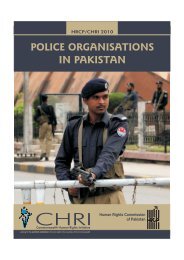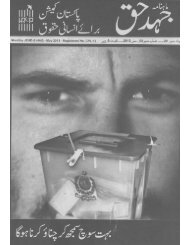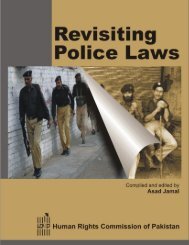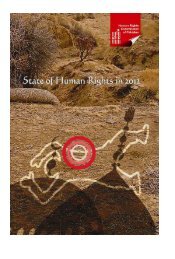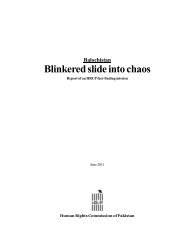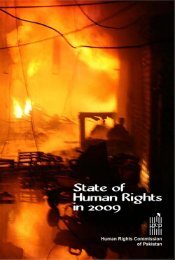Download PDF file - Human Rights Commission of Pakistan
Download PDF file - Human Rights Commission of Pakistan
Download PDF file - Human Rights Commission of Pakistan
Create successful ePaper yourself
Turn your PDF publications into a flip-book with our unique Google optimized e-Paper software.
the main security threat, the lessons <strong>of</strong> Muharram policing appear not have been much in<br />
evidence in the preparation for May 12. In fact, some <strong>of</strong> the known preparations for May 12th<br />
were in direct contradiction to the lessons <strong>of</strong> successful policing <strong>of</strong> Moharram processions.<br />
While there is some logic in setting up roadblocks and barricades to channel rival processions<br />
away from one another and to restrict the number <strong>of</strong> entry points into the main procession<br />
route, the setting up <strong>of</strong> barriers across the main route <strong>of</strong> the rallies – i.e., on Sharah-e-Faisal –<br />
appeared to make no sense at all. Rather than facilitating the passage <strong>of</strong> the two rival rallies,<br />
the barriers actually ensured that none <strong>of</strong> the rallies could actually pass.<br />
There is no evidence either <strong>of</strong> a serious attempt at negotiating a time-lag between the<br />
two potential rival rallies. There was an indication that among the options being considered by<br />
the government one included allowing the CJ to move from the airport after the MQM rally<br />
had ended. It is not known if this option was pursued with any seriousness. There is also no<br />
evidence that the authorities made any attempt to persuade the MQM to alter the route or<br />
timing <strong>of</strong> its proposed rallies along the National Highway/Sharah-e-Faisal corridor. As it<br />
turned out, there was no MQM rally along the National Highway/Sharah-e-Faisal corridor<br />
towards the Quaid’s Mazar and M.A. Jinnah Road. It is, therefore, quite likely that the<br />
authorities had already decided that there would not be any rival rallies along the route. The<br />
objective, it then appears, was to obstruct opposition rallies.<br />
The roadblocks were also the wrong instruments for dealing with the other three<br />
security threats, as perceived by authorities. Again, as the experience <strong>of</strong> VVIP movement<br />
along the Shara-e-Faisal corridor shows, avoiding any <strong>of</strong> the three kinds <strong>of</strong> threats requires<br />
blocking <strong>of</strong> entry onto Sharah-e-Faisal from the side roads and unimpeded flow <strong>of</strong> traffic along<br />
the corridor. While the former procedure was carried out, i.e., entry onto Sharah-e-Faisal<br />
from the side roads was restricted, the placing <strong>of</strong> barriers across Shahrah-e-Faisal created ideal<br />
conditions for an assassin, a suicide bomber or a terrorist aiming to target or ambush anyone.<br />
HRCP<br />
2. Flashpoints on May 12 and After<br />
At least 34 people were killed and 140 injured on May 12 th alone as parts <strong>of</strong> Karachi<br />
turned into battlegrounds 41 . The main areas that saw fierce clashes between rival groups were<br />
along the National Highway/Shahrah-e-Faisal corridor, as well as in other parts <strong>of</strong> the city.<br />
The situation was so grim that the Jinnah Postgraduate Medical Centre (JPMC) receptionist<br />
asked those enquiring for their loved ones to first check the morgue 42 .<br />
An overall picture <strong>of</strong> the May 12 events is reconstructed in this section using published<br />
accounts and individual testimonials <strong>of</strong> victims and eyewitnesses. An attempt is made to<br />
identify flashpoints, or locations where violence and casualties are known to have taken place,<br />
and to provide an account <strong>of</strong> what happened at these various locations during the course <strong>of</strong><br />
the day.<br />
The earliest reports <strong>of</strong> violence relate to the difficulties experienced by lawyers in<br />
reaching their designated meeting points in the City Courts, the Sindh High Court and the<br />
Malir District Courts respectively. This violence was threatening but mostly non-lethal.<br />
However, from around midday onwards, many segments <strong>of</strong> the National Highway/Sharah-e-<br />
Faisal corridor experienced intensive use <strong>of</strong> firearms and a large number <strong>of</strong> casualties and<br />
injuries caused by firing. Violence then spread to other parts <strong>of</strong> the city from around 1.30 pm<br />
41<br />
Dawn 13 May (i)<br />
42 Daily Times 14 May (b)<br />
10



